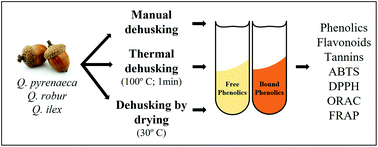Unveiling the phytochemical nature of acorns: the relevance of dehusking†
Abstract
Acorns are an abundant but despised fruit in Portugal. To explore this resource, the effect of different dehusking methods (thermal dehusking and dehusking by drying) on the phenolic contents and antioxidant activity of different acorn species from Peneda-Gerês National Park was studied. Regarding the free phenolics, the phenolic contents and antioxidant activity values of Q. pyrenaica decreased after thermal dehusking and dehusking by drying. Similar results were observed for the thermally dehusked Q. robur acorns, despite the increase in gallic acid. However, the phenolic contents and antioxidant activity values increased when Q. robur acorns were dehusked by drying, despite the decrease in ellagic acid and ORAC antioxidant values. The phenolic content of Q. ilex acorns increased after both dehusking methods due to the increase of ellagic acid, which led to the increase of the ABTS, DPPH, and FRAP antioxidant activity, but the ORAC antioxidant activity decreased. In the bound fraction, the phenolic, flavonoid, and gallic acid contents increased for all species when dehusked by both methods, thus increasing the antioxidant activity values. The thermal dehusking had a very dependent effect on ellagic acid content between species, while the dehusking by drying increased the ellagic acid contents for acorn species.



 Please wait while we load your content...
Please wait while we load your content...